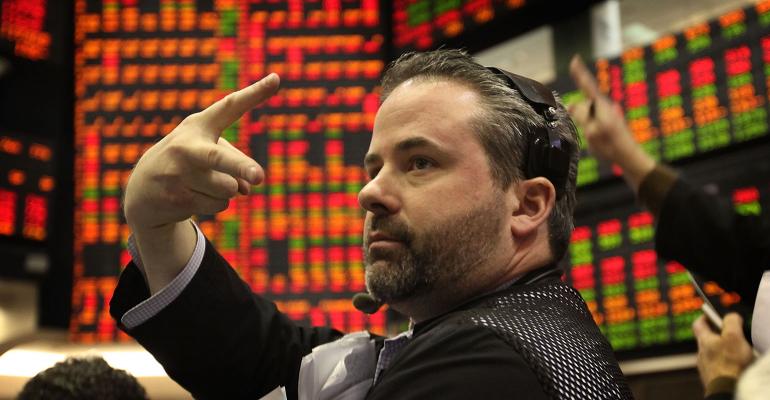By Graham Allen
Since the recent peak in the S&P 500, the index has undergone a 10 percent correction. During the period, the 10-Year Treasury bond yield has risen to 2.77 percent from 2.66 percent, and has not fallen as you would expect.
If, as many have speculated, this represents the beginnings of a bear market in stocks, is it reasonable to expect that the U.S. Treasury market should have acted differently?
Many think a real flight to quality in anticipation of an economic downtown would have initiated significant Treasury purchases and pushed yields lower.
However, the U.S. high yield market has also had a muted response to the equity sell-off, widening only 50 basis points from the recent tights to +360 over U.S. Treasurys as measured by the Bloomberg Barclays High Yield Index.
This further implies that the correction is simply that, and not a harbinger of worse things to come.
Let us therefore briefly examine the background of the relationship between these two markets and assess what the interplay could tell us about the future.
Over the last year, there has been a high correlation between the S&P 500 and the U.S. 10-year Treasury yield. As stocks have risen, so too have 10-year yields. The 10-year bond yield peaked at 2.94 percent about a month after the recent high on the S&P 500, and has since fallen slightly to 2.77 percent. In that time stocks have sold, off by 10 percent, which happens to coincide with the first Fibonacci resistance level of a -38.2 percent correction since the rally began in 2016. This support remains key in the short term for equities. The modest rally in the bond market, at a time when global inflation outlook continues to remain benign, is therefore surprising and is perhaps indicative that the equity sell-off remains temporary in nature.
However, equity markets have led the bond market in the past, with a typical lag time between a major sell-off in equities and a pronounced bond rally up to two months, as was the case in 2008. So near-term equity performance could hold the key to lower U.S. interest rates.
Given this, what is the likelihood that this equity market correction turns into a more serious sell-off? From a fundamental standpoint, there is little to support a negative outlook globally. Here are some things to consider. Earnings continue to be strong with the S&P 500 first quarter 2018 earnings predicted to be ahead by as much as 25 percent. At its peak, the index was valued on a forward P/E of around 18.2, which is high given the historical range. At present day levels, with predicted earnings levels, the forward P/E drops to a more attractive 16 for 2019 and 15 for 2020. To be sure, an adjustment was likely at the recent high of 2,872 on the S&P 500, as inflation expectations were rising at the time. Since that time the expectation of higher inflation has waned. In many major economies, inflation rates have actually begun to fall recently, China being a good example.
Secondly, dividends have also increased, registering a 9 percent increase in the first quarter of 2018 alone. It’s estimated that in second quarter 2018, up to $400 billion in dividend payments could be available for reinvestment into the markets. This is supportive of higher equity prices.
Globally, fiscal stimulus continues to increase following a healthy acceleration of growth in 2017. Equity markets have shrugged off the uncertainty of several important general elections in Europe, with even the uncertainty surrounding BREXIT receding in the minds of investors. Generally, growth in 2017 came in above expectations, especially in Asia. Both Japan and China outperformed forecasts made at the beginning of 2017, especially the former, which has nominal GDP growth of more than 10 percent.
From a monetary policy standpoint, central banks are still on balance in an easing mode with interest rate cuts exceeding rate increases around the world. This is more pronounced in the emerging market economies such as Brazil where the Central Bank continues to make cuts in the light of waning inflation. The full effect of lower interest rates on growth is yet to be felt in these economies, and will add to momentum in world GDP.
Therefore, the reason bonds may not have rallied to the extent justified by the equity sell-off may be because the bond market still anticipates a pickup in growth that ultimately could lead to higher inflation. But so far, this has NOT been reflected in headline inflation reports. Some European Central Banks have actually downgraded their inflation limits recently as their respective economies have struggled to reach the targets. That said, there are finally signs that conditions may be building for some inflationary pressures to manifest.
Global employment levels remain historically very high. This has led to wage pressure building in Eastern Europe and even parts of core Europe, such as Germany. Labor shortages are finally leading to wage pressures. Production capacity around the world is also still very high, and will continue to absorb higher demand for some time without affecting prices, provided trade tariffs don’t become too disruptive.
In conclusion, we believe the action of the bond markets continue to anticipate a global pickup in growth for the foreseeable future. Treasury markets have not reflected a flight to quality, and credit markets don’t seem to indicate a major deterioration anytime soon.
Given that, equity valuations at their peak looked high, even though the earnings outlook was good, a correction was not only overdue, but healthy in the long run.
Graham Allen is Senior Portfolio Manager at Tortoise Credit




